Dec 23, 2025
Dec 23, 2025
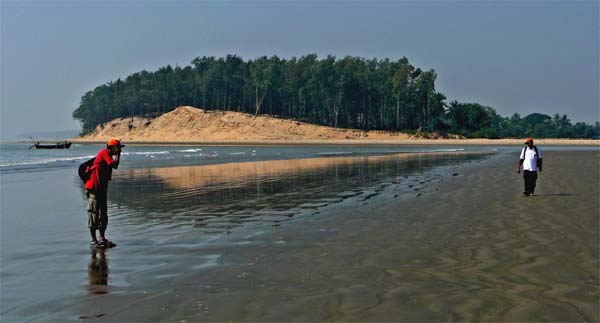
I love to trek alone, or with one or two friends. However, when Arjun, my occasional trekking partner, says that Adventure Sporting Club, Chandannagore (of which he is a member), would be organizing a coastal trek from Chandipur to New-Digha, I agree to join them for two reasons.
First, I had no previous experience in coastal trekking. Secondly, coastal trekking is a team game, and the better the team the better the experience.
Adventure Sporting Club, Chandannagore, has many successful expeditions under its belt. Recently they have returned from Everest Base Camp expedition. I have previous acquaintance with some members, so, I do not hesitate to accept Arjun’s offer.
Peparation
Our team members are – Sushil Mohan Talukdar alias Bara-da (73), Subodh Acharya (64), Raren Dutta (64), Sekhar De (59), Subrata Chatterjee (58), Alok Dutta, alias Babu-da (54), Jayanta Kundu, alias Kundu-da (50), Prasanta Biswas (47), Arjun Nandi (40), Shantanu Das, alias Hari (40), Sanjiv Sarkar (40), Srikanta Pal, alias Patol (38), Prasanta Manna, alias Shanko (35), and Prantik Roy (24), and of course, I.
In short, the senior-most member is Bara-da of 73 years, and the youngest is Prantik of 24 years.
Kundu-da is the team leader.
White T-Shirts and saffron cap (no! no agenda implied) with the club’s logo, and a ‘must-carry’ check-list are distributed to the participants at a pre-tour meeting held at the secretary Tarun-da’s house.
Our tickets for Balashore are booked in East Coast express scheduled to depart Howrah at 11.45 am on 09-11-11.
The regions we would trek will be much important in the coming years in Orissa’s economy and development.
14 locations have been identified on Orissa coast to be developed as port. These locations include Chandipur (Balasore), Bahabalpur (Balasore), Subarnarekha mouth (Kirtania) in Balasore district and Talsara (Balasore) – the places we would touch. Most of the locations among them have already been developing as port in the public private partnership (PPP). [http://wapedia.mobi/en/Orissa?t=4.)
Day-1
Reaching Howrah at 10.30 am we get the first bad news that East Coast has been re-scheduled to depart at 1.15 pm. We spend the time chatting, and sipping coffee. Our rucksacks and common luggage consisting of two gigantic stoves, kerosene, and snacks and ration etc. (which is referred to by the team as ‘company-mal’), as also our dress often became a matter of curiosity to other passengers.
As the train starts, our food exploration begins.
Adventure Sporting Club’s philosophy is simple: ‘Have an adventurous spirit, walk hard, and never forget to satisfy the Appetite-God.’
The menu for our lunch is bread, ‘palang-panir’ prepared by Kundu-Boudi (Kundu-da’s wife), and of course chicken curry. Before we finish, the second innings with choicest sweets from Kolkata and Chandannagore takes over.
The train, already delayed, delays more. Sometimes, our train perches peacefully at unknown stations, while known trains whoosh by.
We reach Balashore at 6.35 pm. Some members get busy for marketing – the cereal and vegetable ration for next two days. Some members book a matador that would take us to hotel in Chandipur. We reach Chandipur – 16 km from Balashore - at 9 pm.
We book a dormitory of 16 beds at Hotel Anandamayee. This time of the year, there is not much tourist. Members are unhappy that the Hotel charges us Rs. 1500 for the dormitory and Rs. 500 more for lending us a space for cooking. Since we reach late and have few options, the hotel authority has the upper hand in the bargain.
Chandipur-on-Sea is a well-known tourist spot and sea-side resort. It is studded with casuarina trees. The beach has a unique feature. During low tide the waters recede up to five kilometers into the sea exposing the sands of the beach and the hard sea-bed with varied designs. Even beyond those 5 km for some more distance the waters are not thigh-deep.
Chandipur-on-Sea is important to our nation for another reason. This place is also the location of the Indian Army's Integrated Test Range (ITR). A number of successful missiles like - Akash, Agni and Prithvi - have been launched from here. That area is of course restricted zone.
Day-2
We all rise early to see sunrise. But the beach frustrates us.
Even at night we heard cracker sounds. The reason now becomes apparent.
There are hundreds of people on the beach – all locals. Some young enthusiasts are cracking crackers spoiling the serenity of the morning. A local festival related to sea-trade of ancient times is going on, and locals in hundreds have thronged the beach.
Shanko, Patol and Arjun get busy with preparing our breakfast.
After breakfast with Luchi-Tarkari and sweets, we start our journey at 8 am. We reach Balaramgadi village at the Buribalam river mouth at 8.30 am. We walk upstream the bank of the river to reach the Ghat through the shore forest. At one place there is a huge dump of conch shells and oysters.
Seeing a crowd before a tree as we pass the forest, we are curious thinking some fun going on, and go there.
It is a sad sight. A young boy hangs by a rope from a tree. Probably he committed suicide last night. Local people throng the scene, and debates are on – whether it is suicide or murder. Police has already arrived at the scene. We leave the place quietly.
We have tea at a local shop, and then we proceed to the Buribalam Ghat. It is about 2.5 km from our hotel.
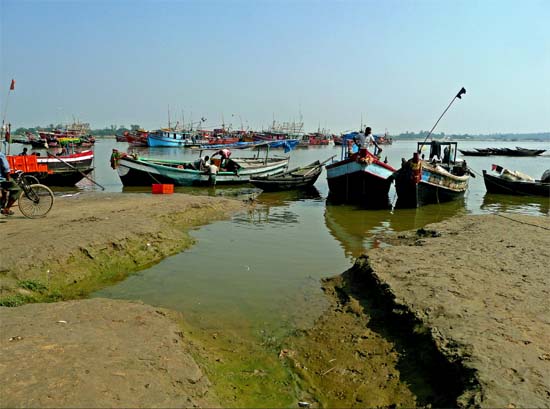
This is a picture of Buribalam River. We see trawlers and busy fishermen. Negotiating the muddy riverbank, we board a boat! The boatman charges Rs.5 per head.
The other side of the river is Joshipur. This place has a historic importance in India’s freedom struggle. The indomitable Bagha Jatin fought here with country guns against the mighty British rifles. The exact location is however 1 km inland on Buribalam River.
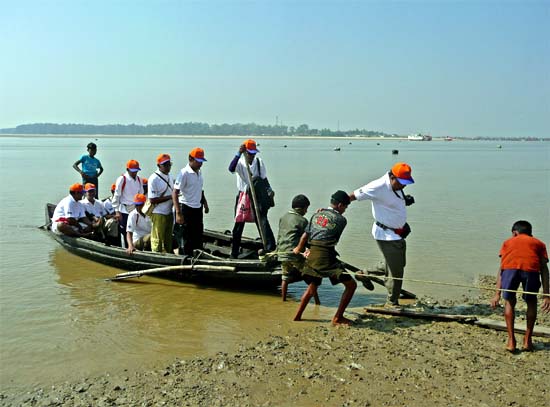
This is a picture of our team as we step on Joshipur.
Careful with the muddy bank, we trekk south-east to reach the sea-beach.
After a leisurely walk of about half an hour, we reach village Majhichak 1.2 km away. We pass fisherman and their women-folk drying fishes and prawns on plastic sheets on the sand. On our query, they say that dry prawns fetch them Rs. 100 per kilogram. Touts get richer at the cost of their labour. Same picture everywhere.
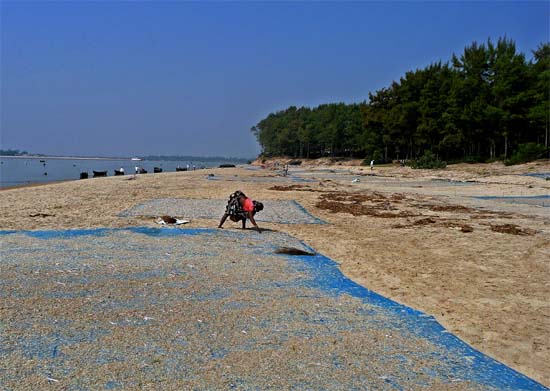
This is a picture of a woman of Majhichak drying prawns.
By now, we have already been ‘acclimatized’ with Fish smell. Fish smell and mild salty breeze provide us the necessary atmosphere.
Our next destination Bahabalpur, and our halt for today – Kosafal are visible at the distant horizon. It looks deceptively near – the forest-line narrowing like a sharp spear, and the end of the sharp tip at a far horizon indicating the mouth of a river – yet we know we have to walk another 9.5 km to reach Bahabalpur.
The next part of the trek to Bahabalpur is the most sense satisfying. We see marine animals, red crabs and variety of birds. We see beautiful landscape formation of sand-hills, and designs on the sand. A species of small crabs create beautiful designs while digging hole in the sand. Another small species of birds leave trident foot-prints on the wet sand as they hop.
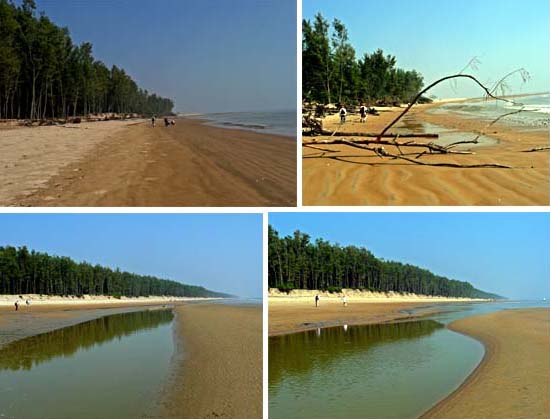
These are four pictures of our team walking to Bahabalpur.
We reach Bahabalpur after a continuous walk of 2 hours. Only for 15 minutes we had a break in the Casuarina forest, where, in the shades, we had biscuits and glucose. Then we decided to walk for sometime through the forest. The forest is an artificial one, many of them built after the tsunami of 2004, or for coastal sand and wildlife preservation, and the trees are arranged in line. Despite the ‘editing’, nature is natural still.
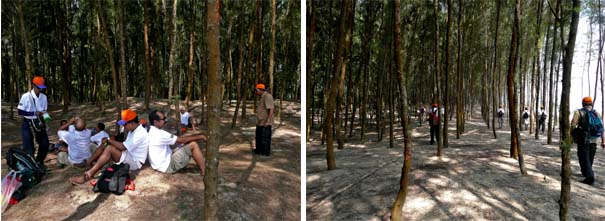
These are pictures of our team taking rest in casuarinas forest, and walking through the forest.
Occasionally we see lone boats in the sea or on the sand that make the mind reflective. It is a paradise for abstract photography.
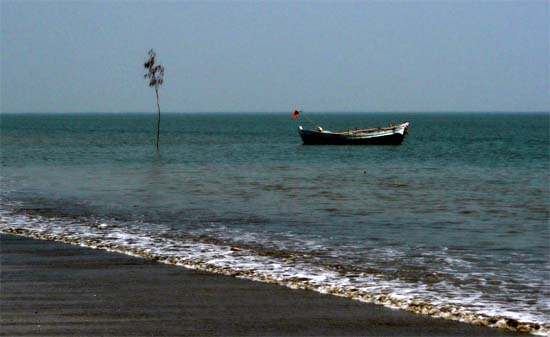
A lone boat.
At Bahabalpur, Buriamari River meets the Bay of Bengal in two streams forming a Wave-dominated Delta between its two streams. I call the west stream 1st stream, and the east stream 2nd stream. The Delta advances into the sea to the shallow seabed beyond the apparent coastal line. It is sandy. About half kilometer before bifurcating, Buriamari, on its left side, bifurcates and forms an inland Delta that is Tide-dominated. This Inland Delta is fertile and cultivable. This distributory stream (I call third stream) around the Inland Delta comes back to meet Buriamari’s second stream, where it confluences with another river coming from the east – River Dugdugi, also called Dumduma by some locals. Thus an Estuary is formed. The confluence of Buriamari’s second and third stream and Dugdugi falls in Bay of Bengal.
From above, Buriamari’s mainstream, the three streams and Dugdugi, would look like a sprawling giant five-armed starfish. Perhaps for this five-armed illusion, the river confluence is also known as Panch kora. It is also called Kosafal confluence. (For the satellite picture, please see - http://wikimapia.org/#lat=21.5157642&lon=87.1257877&z=14&l=0&m=b)
From Bahabalpur Ghat on Buriamari’s mainstream, we board a boat (Bhutbhuti). It passes the sharp inland-facing tip of the Wave-dominated Delta, then the sea-facing tip of the inland Delta, and then enters the Dugdugi. Now, our boat floats along the upstream of Dugdugi for a while to reach the boat jetty at Kosafal village. We reach there at 2.30 pm.
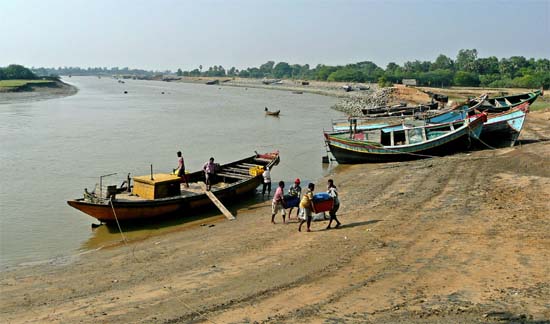
Boat jetty at Kosafal on Dugdugi River.
Arjun is happy to find a Pan-shop (beetle). While others rest beneath a tree, Arjun is busy ordering Pans.
Kosafal is not yet a tourist spot; as such there is no ‘formal’ place for tourists to stay.
Taking advice from fishermen and locals, we walk another 1.5 km inside the village. Kirtans are going on in many houses. The village seems to be much religious-minded. We pass a nice Radha-Madhav temple.
While walking, we face many queries about us. One woman even asks whether we are Maoists, and another man almost bumps into me to read the logo on my T-Shirt.
Soon we get a cordial welcome that we did not expect.
Taking the left track of a bifurcation – the right of which leads to the sea - we reach a place of public worship – the like we call in Bengal, Barowaritala. It is an open place with an aura of open-air stage at the middle. On one side, there is a temple. A young priest reads ‘Panchaali’ to village women as they listen with much devotion though occasionally punctured by curious glances to us. The clean-shaved well-groomed priest becomes conscious of our arrival, and his voice becomes louder and more rhythmic.
One man, riding a bike, with an obvious ‘important’ demeanour, helps us much. The villagers allow us the Primary school for night-stay. One Parabas Patra is of immense help. He calls a boy, who agrees to make arrangements for electric connection – not the legal way, of course. Parabas also orders tea for us at the nearby tea-shop.
We reach the school, and are happy to find abundant water supply, and clean rooms.
Portraits of Ramakrishna, Vivekananda, Subhas Chandra Bose, Sarvapalli Radhakrishnan, and Gandhiji on the walls reveal to us how respectful the villagers are to these great men.
Shanko, Hari, and Sanjeev have no time for reflections, and immediately go out for ‘fishing’ fish, as the rest of us get busy to have bath, and prepare the classroom for our stay.
Hari promises not to return empty-handed without pamphlets.
Alok-da and Prasanta-da go to the beach to enjoy the sea at sunset time.
After the Fish-hunters return, Shanko, Patol, and Arjun get busy with pamphlet fish cuisine to give us a memorable dinner true to the philosophy of the Club.
As evening falls, our electric supply already been established, the members take turn to charge camera and mobile batteries, and themselves with snacks and nap. Kirtan is sung nearby with high decibel.
It is a luxury dinner par excellence at 9 pm after a first-day trek. Each of us has his own plate, spoon and glass. Shanko and Patol cater to the buffet.
After our dinner, it is picnic-time for stray dogs. They have already accepted us as guests, and barked no more. We reward them profusely.
The only problem is mosquitoes that refuse to be cordial and show us any special favours, and force us to burn mosquito coils and hang mosquito nets.
Mosquito-bite is undoubtedly a great leveler.
We spend the night with sound sleep. Some of us choose to sleep outside on the verandah.
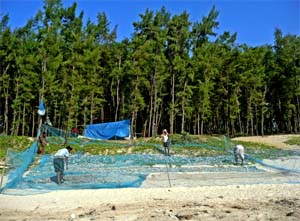 The villagers of Kosafal are mostly fisherman and farmers.
The villagers of Kosafal are mostly fisherman and farmers.
I gathered information that this is indeed a temple-village with many temples like-Radhamadhav temple, Khiromatree temple, Baba-Bakreswarnath temple, Siddheswar temple etc.
Many festivals like Baruni-Snan and Kunja Mela are observed in this village. The festivals are observed at the end of Indian year.
Kunja Mela is famous for "Kabadi Game".
The Baruni festival is devoted to worship of Lord Shiva. On this day the devotee boys, girls and elders make a pilgrimage and take ritual bath in the rivers. The pilgrims present their offerings to the Shivalingas. Kirtans are also arranged in the temples.
The region is an interesting mixture of Shakta, Shaivaite and Vaishnava cults.
Day-3
We get-up at 7 in the morning.
After a heavy breakfast, we broom the school-room clean immediately, because school would start soon and we had promised to leave the premise before that.
We start at 8 am. Today, our destination is Dogra – at a distance of 20 km.
We reach the sea-side by taking a village path – short-cut. We pass ponds full of blooming lotus, well-shaded beetle-cultivation, and gazes of curious woman-folk.
After walking for 5.8 km along the shore, we reach a beautiful small river at 9.30 am. The river is small, yet chest-deep at the middle. Local people call this Chaulti River.
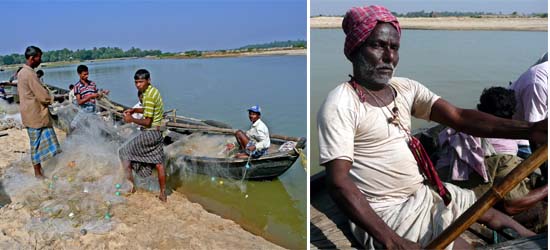
Fishermen are busy at Chaulti River. Senior members take some rest under casuarinas shade some distant from the bank, where a fish-market goes on full-fledged. An old boatman agrees to take us across - four at a time.
The boatman is an archetypal boatman in all respect. As the first batch to cross hurries to board, he scolds mildly.
It is not a very pleasant boat-ride for Prantik who does not know swimming. Even for some others, the ride occasionally offers tense moments as the boat sways so much that its edges almost touch the river – giving almost a near-sensation of boat-sinking experience. The boatman often reminds to sit quietly and not to move. The batch that has reached the other side is now busy taking shots of the plight of the new batch crossing. There is much laughter and name-calling.
Amidst this, the only comfort is the old boatman’s constant solace ‘kuchhu hobe ni’ (‘nothing will happen’). Old experience knows better, and young experience thinks himself smarter only to be proved wrong.
The boatman charges Rs. 70 for the four trips.
The other side has a single tree on the white sand providing shade. The forest is half kilometer away. It is a prize-watch some fishermen weaving fishing nets with apt speed.
We take rest and snacks under the tree, and start again at 10 am.
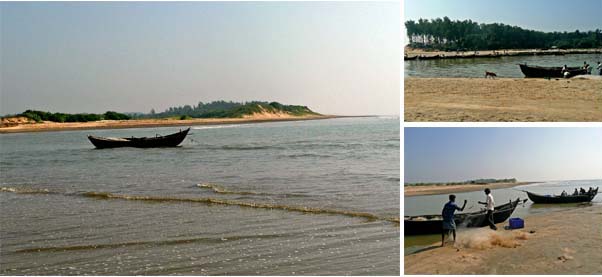
Chaulti River mouth.

Turning back, Chaulti River-mouth gifts us a beautiful scenery.
We reach Haskara Khari at 11 am at a distance of 3.6 km from here. Now it is low tide, the river-bed is visible in transparent water, and taking clue from some cows crossing it, we gather it would be hardly knee-deep. Two boats float on it anchored with rope. There is no person nearby.
As we cross the river on foot – a mild ebb-current adding to our pleasure – Patol would not loose the opportunity to drench Arjun to earn expletives.
There is a constructed shade nearby. All rest comfortably beneath it.
I and Arjun decide to take bath. I go behind a boat to hide myself from others, return to my natural state placing my dress on the boat, and have a most fulfilling bath in the most kingly fashion. Arjun has no such pretences. He prefers to stay in front of the boat.
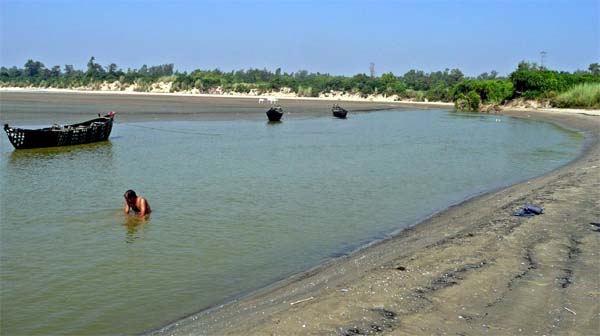
My friend taking bath at Haskara Khari.
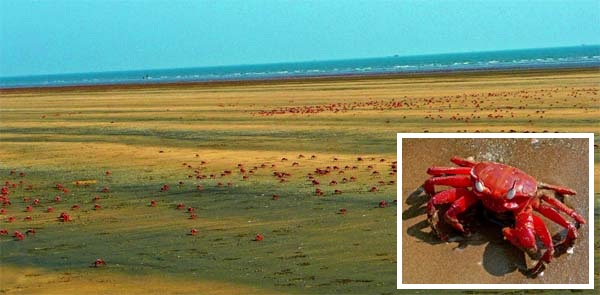
Day-4
Next day after quite a heavy breakfast of Parota-Alurdam, we start from Dogra at 9 am. It is a rewarding trek.
Then we pass Dagara and Chaumukh village (though not visible from the beach) and reach Kankadapal village on the bank of Subarnarekha at a distance of 10 km.
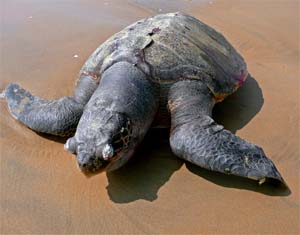 Enroute Kankadapal, we find a huge dead turtle near the sea-line. It must have died last night because it looks so live. It has not yet drawn attention of carcass-eaters. We are saddened and speculate whether it has been hit by a trawler.
Enroute Kankadapal, we find a huge dead turtle near the sea-line. It must have died last night because it looks so live. It has not yet drawn attention of carcass-eaters. We are saddened and speculate whether it has been hit by a trawler.
Arjun finds a sea-snake struggling on the sand. It is half-dead. Arjun puts it back into the sea with a stick. Let fate decide now.
One kilometer before the river-mouth, on the advice of some fishermen, we turn left to take a path through Kankadapal to reach the Ghat at Subarnarekha beach for crossing Subarnarekha. There is a Bankabihari temple in this village. We pass through a marshy land. Some little girls, curious of our discomfort in negotiating the marshy tract, advise us on where to step. Then we follow a village path parallel to the sea-coast but at least ¾ km from the sea, and then finally through some private lawns to reach the Ghat.
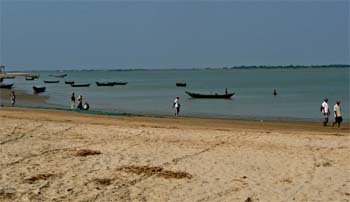 Subarnarekha offers us one of the most beautiful sights in this route. A river meeting the sea is always beautiful, and tryst itself is beauty’s Self!
Subarnarekha offers us one of the most beautiful sights in this route. A river meeting the sea is always beautiful, and tryst itself is beauty’s Self!
A Bhutbhuti charges us Rs.200. As we cross, spectacular sea-birds keep us busy with our cameras. It took us 35 minutes to cross the river.
The other-side is Kirtaniya Ghat. It is initially muddy. We have to be bare-footed for sometime.
Kirtaniya Ghat has a fishing harbour and bazaar. We take a trail through the village. It is impossible to trek on the coast here because the land is marshy and full of ‘khari’ and deltas.
After a muddy trail, we reach a metal road that goes to Rankotha village. At the juncture of the muddy road and metal road, Shanka and Patol see coconut trees, and as usual decide not to overlook them.
The road enters Kirtaniya village on the left, but we move right. There are several neighbouring villages like Fulbani, Jalsoharia and Shantinagar to the north-east of Kirtaniya.
We take rest in a local people’s house near the juncture of the muddy path and metal road. The owner and his son get busy to bring down high-flying coconuts. The man says this place is called Narayanmaiti.
As we sit in his house, some senior members stretch a bit on the lawn. Then comes the coconut with milk like manna dew.
After that, walking another 1.5 km towards Rankotha village on metal road, we take a right turn along a muddy path through Matikacha village (3 km from Kirtaniya) that leads to Talseri still 7.8 km away.
Between the sea and us is a river that runs almost parallel to our way that meets about a kilometer west of Subarnarekha river-mouth. It has many tributaries and distributaries. The other end of the river meets the sea at Talseri and is known as the Talseri River. Actually this is an inland water river with both ends meeting the sea, forming several marshy intractable deltas, the largest known as Subarna Island. The river is never visible, only its presence is felt sometimes by high embankments far away.
We pass through Matikacha village and through forest and a crematorium till near about 1 km from Talseri we finally get the river on our right. A trail along its left bank for a brief spell takes us to Talseri fishing harbour and then to hotel Sagar Saikat – our halt for today.
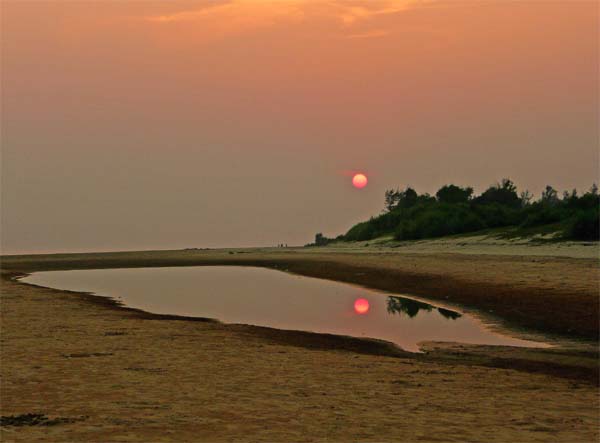
We see a beautiful sunset in a pool of water.
Muri-chanachur at evening with onion and green chilly, and chicken for dinner relieves us of all fatigue.
Day-5
Talseri to New-Digha is only 4.5 km trek along the coast. At a distance of 2.5 km is Udaypur beach, and then New-Digha.
It is after Talseri that we bid good bye to Orissa and enter West Bengal.
Udaypur and New-Digha are popular sea-side haunts. After Talseri it is more people than crabs and birds. Our actual coastal trek has ended at Talseri.
After lunch, we walk to New-Digha railway station, avail Duronto express and reach home.
Some tips for enthusiasts
On the third day of the trek, I developed foot-burns because my choice of foot-wear was not correct. I took a new hunter shoe and the resultant foot-burns restricted my speed other than causing much pain during the last 10 km trek.
It is better to take a foot-wear with which one is accustomed. Anything from slippers to trekking shoe would do; only, one must be well used to it.
Except Kosafal, the other halts (Dogra, Talseri, New-Digha) have roofs and walls to stay comfortably. The trekking should be arranged keeping Kosafal in mind. If one can mix with people, then uncertainty is another glorious certainty.
Snacks and dry food must be carried. Also water. Major food for lunch and dinner is available in the village hotels. With three-star or five-star mentality, village hotels are certainly not fit. However, with trekker’s mentality, everything is just fine.
We often started late in the morning because of cooking factor. Because of over-emphasis on food, I missed the opportunity of trekking the coast with the splendour of rising sun. My advice is to start early, take rest when the sun is hot, relax and walk again. By normal walking speed, one can easily cross 4 km per hour.
Don’t forget to take medicines. That is most important. Anti-biotic for loose motion and dehydration is a must Must. Anti-septic, leucoplast, band-aid, cotton, crap bandage must be taken.
To enjoy trekking as well as the rivers and sea, it is better to wear shorts or Bermuda.
Cap is a must.
Sun-cream is optional, and not necessary. In any case, the complexion will gain a dark parlour that would remain for some days. It is advisable, therefore, not to undertake the trek just before marriage, pre-marriage ritual parade before would-be-in-laws, or fashion-shows.
The trekking would not cost much. However, money must be in cash, and in small denominations. Average cost per head per day during the trek would not exceed Rs. 500 by any means of luxury. The villages do not accept credit or debit card or cheque. There is ATM at Balashore railway station and New-Digha. No machine can produce money in between.
Carrying mosquito net is another must. It is a burden, but the mosquitoes are not cordial and rational.
Carrying torch, candles and match-box is another must.
It is better to arrange the trek during October-November. Summer months are advisable for those who enjoy being roasted alive.
Words do not end: a few words more
That’s all about our very nice coastal trek.
Throughout the route, we saw many species of birds. I am a bird-lover but I know not much about them.
Earlier I learnt that according to surveys since 2000 there are about 120 bird species on this coast. From the reservoir of my little knowledge, I think I could identify Whiskered Terns, Little Terns, kingfishers and Greater Sand Plovers among other birds during the trek.
I thank Chandannagore Adventure Sports Club for giving me a new experience with some nice persons.
One final word.
I cannot end this travelogue without mentioning Bara-da – Mr. Sushil Mohan Talukdar – the very young man of 73 years. Throughout the trek he spoke less, enjoyed every experience, participated in jokes, fun and laughter, and whenever he spoke, he spoke meaningfully and wisely. I end this writing, dedicating this travelogue to this man, whom I consider a role-model for adventure-loving young-minded people of all ages.
However, Bara-da is a bachelor. This action may not be emulated, or if emulated, it is at your own risk for which the author reserves the right not to be held liable.
12-Nov-2011
More by : Indrajit Bandyopadhyay

|
Good day Sir, Great to read your travelog reg. Chandipur, to New Digha trek. Could you pls share exact Route Map, distance between places, local person/guide contact? Have heard some quicksand incidents in the past. Have you crossed areas or tell us what to avoid. Planning to explore this winter. Thank you. Kind regards Pritam 9051469753 |

|
Hello Everyone, Special thanks to Mr. Indrajit for writing this blog and making me interested one of the off trek. Please anyone is interested or know more, please let me know so that I can also be a part of the trek. Am 37 years old married residing in kolkata. My mail id is pramanick.arun@gmail.com Please feel free to mail me with details. Happy Trekking! Arunava. |

|
may i get your contact no. pls |

|
@ atanu basu chowdhury @ Atish Nandy - I suggest you read my other coastal trek from Paradip to Konark ... there, I have given more details .. http://www.boloji.com/index.cfm?md=Content&sd=Articles&ArticleID=13962 Pl ask for information if you would ... I am glad you liked the travelogue ... regards Indrajit |

|
Frankly I am overwhelmed and thus have no words to comment.Only the wings of dream have taken a flight and I want to be a part of such expedition,sooner than later.Request all informations please. Atanu |

|
Dear Friend, I am an interested fellow to join a trek from Chandipur to Digha. I am working at Jadavpur University as a Technical Assistant & age 51 Years at present.Let me know about it. Thanks Atish Nandy |

|
Hi Indrajit, At last I found some good travelogue on Chandipur-Digha trek. As I brought up from costal village near Digha, I love sea & sailing from my childhood. Could you please let me know is there same treking scheduled for this Oct-Nov? If yes then please let me know the contact person details. My Email- nilambarish@gmail.com Contact- 9038649213 Regards, Ambarish |

|
@ Susmit Sarkar I would be glad to have you in our team. However, I am sorry that would not be possible this time. I am leaving tonight. Have a nice trek. Before the next coastal trek, I will certainly inform you. Regards Indrajit |

|
wish u all the best....can i know when u r leaving for the trek and the duration of the trek...as we two friends intend to go for the chandipur trek we can easily shift to your trek.....plz let me know soon as we intend to leave on thursday 24th jan at evening |

|
@ Susmit Sarkar wish you all good luck - happy trekking. I am going to a coastal trek again this month ... this time from Paradeep to Puri. Will share the experience. Regards Indrajit |

|
thanks Indrajit for your suggestion....once again I went through your blog as this gives a vivid idea how to successfully do this beach trek....this time we have arranged to trek in winter i.e. this month January, as u suggested....your advices are our frnd and guide..thnks |

|
thank you sir. I am member of "ADVENTURE SPORT CLUB" |

|
@ Susmit Sarkar - I would suggest avoid monsoon months because your enjoyment would be marred for the reasons you are aware of. Better go in winter. Indrajit |

|
Hi Indrajit, thanks for this very nice and descriptive blog on chandipur to digha beach trek.the details are so vivid that i almost feel that i was there with u guys.thnks a lot for all the infos.i myself am planning to go for this trek with one of my trekker frnds...however i am not sure whether this rainy season in august would be suitable time for this trek...as the small streams and kharis u mentioned would become brimful in the monsoon months...and there is also fear of snakes and other venomous creatures.plz help.suggest whwther august would be a good time for this trek.thnks a lot. Susmit. |

|
this is the fantastic experience of nature study.i am also interested to go to the coastal trek but main problem is i have no such experience or guide's about this.i shall be very happy if you supply all data or guideline or contact person who guide me properly.thanking u. |

|
Would you kindly tell me the detailed list of individual items one has to carry for this trip. Also please tell me the food stuff, utensils and stove etc. you carried. Thanks and Regard. Arup. |

|
Excellent. Never I participated in any trek. Still it is enthusiastic. I am now 49 years old. |

|
thanx dr shinde s, I liked your blog Regards Indrajit |

|
the sunset was breathtaking. |

|
Hi Indrajit, I found your blog while googling some information for our forthcoming trek from Chandipur to Digha. I found your blog very informative and really enjoyable. Thank you for sharing your experience here. Regards, Srikant Chakraborty Asansol. |

|
Indra (Indrajit Banerjee) of AVM & HMC Law is always an excellent story teller both in terms of text and photo. This is another such example if his. He used to draw nice pencil sketches also. An avid mountain lover especialist in Garwal Himalayas and love trekking alone. Indra is also Vice President of ACHIEVERS ( Kolkata Advocacy Center for Health, Ideal Environment, Education, Research & Social Justice), Hooghly - 712105, West Bengal. |